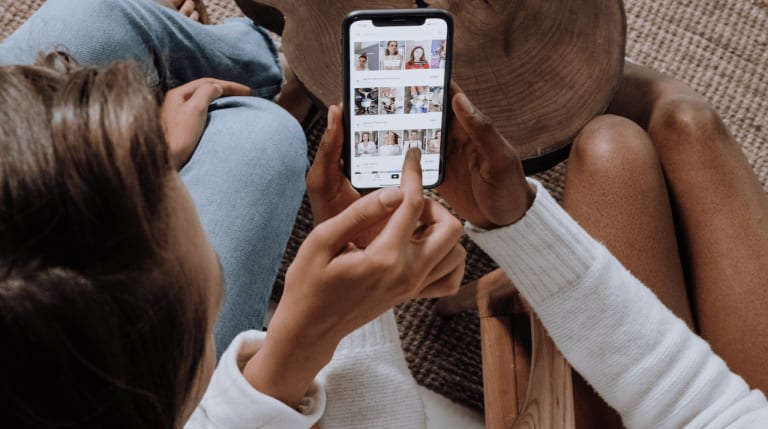A quick three-second scroll on Instagram is all it takes to see post after post of influencers who partner with brands to promote their products.
And there’s a reason why.
With more than one billion monthly active users worldwide on Instagram and millions of loyal influencer-led communities, Instagram can be a goldmine for influencer marketing campaigns. Just ask the nearly 90% of marketers who say Instagram is important to their influencer marketing strategy.
How can you tap into this influencer goldmine and take some of the rewards for your business? In this guide, we will walk you through what influencer marketing is, why it is important, and how to launch profitable influencer marketing campaigns on Instagram.
What is Influencer Marketing and Why is it a Goldmine for Marketers?
Before we talk about what influencers are and what they do, let’s first discuss how influencer marketing can benefit businesses.
- Businesses are earning $6.50 for every $1 spent on influencer marketing
- 80% of marketers find influencer marketing effective
- 89% of marketers say ROI from influencer marketing is comparable to or better than other marketing channels
These are promising statistics. But, instead of just waving some shiny statistics in front of your face, let’s dig a little deeper.
We’ve witnessed the power of influencer marketing, and we know it works. But, let’s talk more about why it is so powerful, and also how this power has waned in recent years, and what marketers can do to adjust to the changes.
The reason for influencer marketing’s rise to power over the last decade is due to two concepts: trust and authenticity.
Consumers grew tired of in-your-face advertisements, pushy sales channels, and biased brand-generated content. As consumers started buying from influencers’ recommendations instead of brand advertisements, businesses realised they needed to take advantage of this trend—or get left behind.
Influencer marketing presented a way for marketers to overcome these hurdles and show consumers their excellent products—without aggressive sales techniques or overt bias.
Who are Influencers?
Influencers are essentially, “influential” people, who boast a loyal following of die-hard fans.
Consumers trust influencers over brands because they are not companies. They don’t have a bottom line to worry about. Influencers are ordinary people who organically attracted large communities of highly engaged and loyal followers, without coercion. An influencers’ communities follow them because they want to, not because they clicked on an ad, or filled out a form.
In today’s online shopping environment, it’s more difficult for brands to be transparent without face-to-face interactions. Yet, consumers crave authentic recommendations and interactions, and influencers provide that for them.
Influencer marketing allows brands to get access to these loyal communities for a fraction of what digital advertising would cost. Instead of fussing with targeting to find your ideal audience, you can get direct access to people who are already interested in what you are selling and are ready (and excited) to buy whatever influencers recommend.
The Tides are Shifting
Influencer marketing has become lucrative for influencers as well. Influencers realised the opportunity to build a business off of their personal brand.
Here’s the problem, though. As more consumers realised how brands partner with influencers, and as more influencers traded their authenticity for a buck, influencer marketing has hit a few bumps in the road.
But, all is not lost—that is, for the influencers who never sold their authenticity. Brands need to shift their marketing strategy and focus more on working with truly authentic influencers who aren’t willing to sell out their communities for a paycheck.
In a later section of this guide, we will discuss how to find these authentic influencers. It may take a little longer to find them, but it will be worth it. You want to work with influencers who genuinely love your product, as authentic influencers will not recommend a product unless they like and/or use it themselves. Avoid working with influencers who will recommend any product if it lands them a check. Eventually, these influencers may lose trust in their communities and dilute their authenticity.
Types of Influencers
There are five types of influencers: Mega, macro, mid-tier, micro, and nano. While numbers may vary, generally, the influencers are categorised by the number of followers:

In this article, we will focus on micro- and nano-influencers, as most businesses typically focus on these two types of influencers.
One of the reasons we recommend working with nano- and micro-influencers is that they are more affordable. Still, more importantly, they have the most loyal followers, which directly affects the ROI of your campaigns.
Influencers with 50K to 250K followers deliver a 30% better ROI per dollar spent than macro-influencers, and a 20% better ROI per dollar spent than influencers with more than one million followers.
Celebrities and macro-influencers don’t enjoy the same level of trust and loyalty as micro-influencers because they aren’t ordinary people, so the majority of Instagram followers can’t relate to them. For example, fashion influencers with large followings may have feeds that look like fashion magazines, yet the regular Instagram follower can’t relate to professional photoshoots and couture fashion prices.
Consumers trust people they can relate to—the part-time Instagrammer with two kids who between managing her chaotic life, takes the time to engage with her loyal undying community and show them what real life looks like—messy and all. These micro-influencers are relatable, vulnerable, and authentic—this is where their power lies.
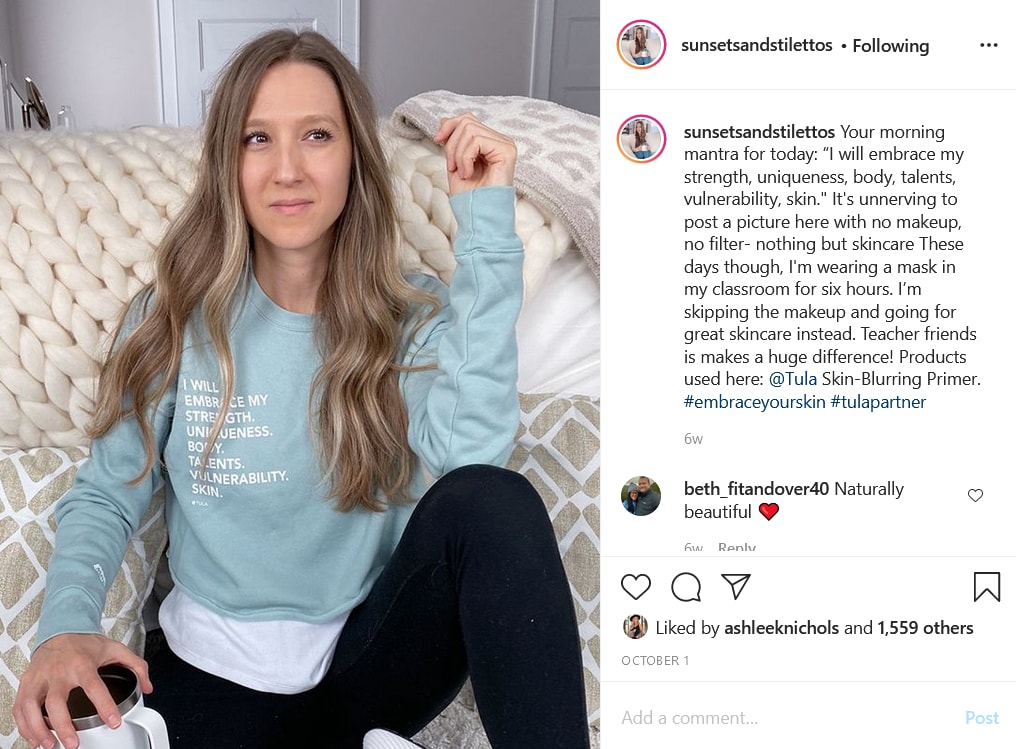
Micro-influencers also focus on specific niches. Coffee-loving fitness instructors will post content on coffee and fitness products because their feed is more of a passion project. They will draw a similar following of passionate coffee and fitness lovers who feel a connection of interests. These niche communities are more passionately engaged with their influencers and more likely to buy from a recommendation because consumers think the recommendation is authentic.
Micro-influencer communities also consider their influencers experts in the niches or passions they post about. For example, beauty influencers build followings of people who believe this influencer has expertise with makeup application, even if the influencer has no professional training. These influencers are good at creating targeted, creative content that strikes a chord with followers.
How Much Does Instagram Influencer Marketing Cost?
We’ve talked about why Instagram influencer marketing is beneficial for brands, but before we dive into how to execute successful campaigns, let’s first talk dollars and cents.
Assessing influencer marketing costs is about as predictable as asking one hundred graphic design freelancers how much they charge to design a website and expecting the same answer.
You will get varying answers from all levels of influencers. According to Later, when asking influencers how much they charge, this was the response:
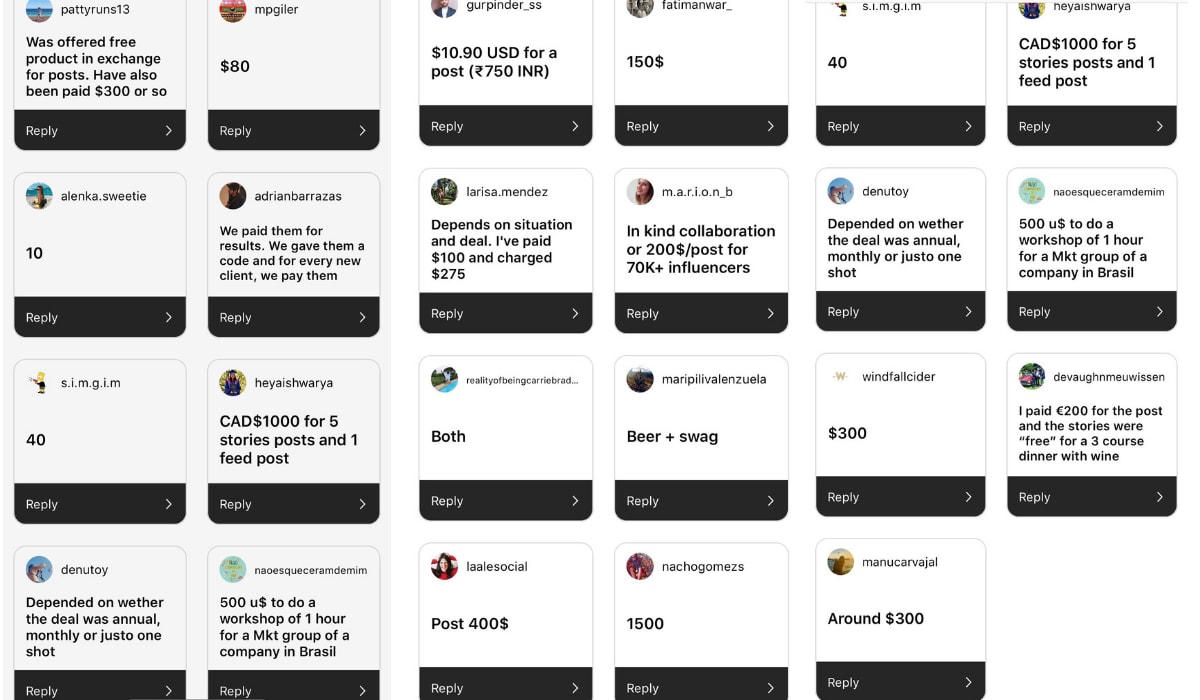
Dizzy yet?
One school of thought is to pay one cent per follower and to adjust from there. So an influencer with 100,000 followers would cost $1,000, and an influencer with 10,000 followers would cost $100.
Engagement rate, creative direction, budgets, production costs, and alternate content (i.e., Instagram story mentions) also affect the cost, and how you negotiate. For example, if you are at a standstill with price negotiations, you could request an Instagram Story mention to seal the deal.
If an influencer belongs to a platform, typically the rates will be more standardised. As the industry has progressed, influencers have become savvier with pricing and treat their sponsored content as more of a business. But, you would be surprised by how many micro- and nano-influencers still accept free products or a small fee in return for a mention. The influencers who would be willing to accept free product are those who either already love your product or would potentially love your product because they match your target audience.
The key here is to take what we say as a starting point and go from there, as your campaigns may follow a different path. Check out this article for more information on influencer marketing costs.
How to Launch Successful Instagram Influencer Marketing Campaigns
Let’s walk through the steps to launching a successful influencer marketing campaign on Instagram. In this section, we will discuss how to set goals and KPIs, how to find authentic influencers, and how to contact them directly.
Before you launch your influencer marketing campaigns or even start looking for influencers, create your goals. This step is critical because your goals will dictate the type of content you or your influencers will produce, your KPIs, and your criteria for selecting the right influencers.
What are your goals? Generally, influencer marketing goals fall into two main categories: brand awareness and conversions.
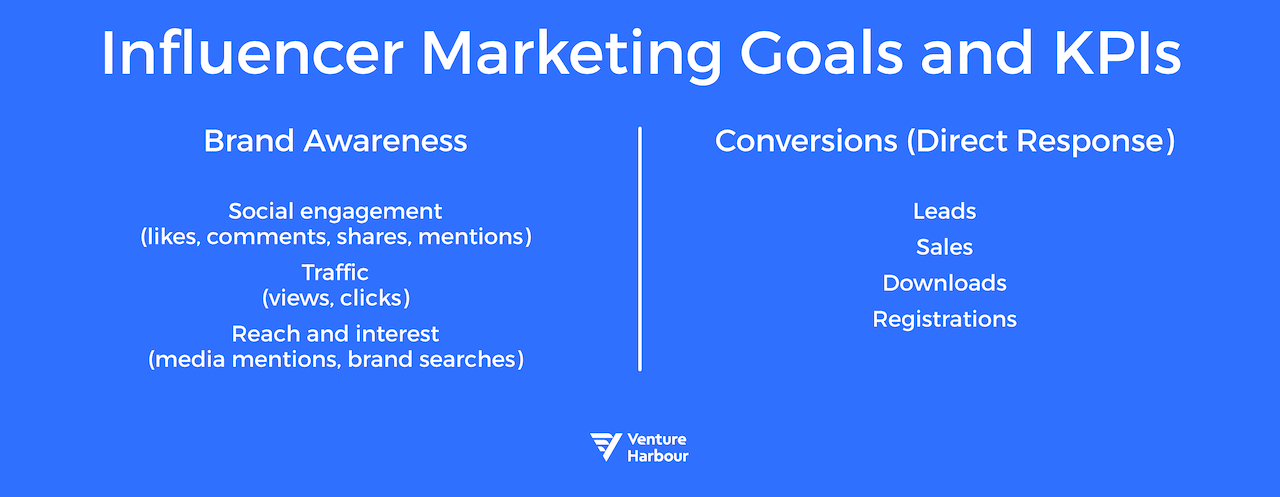
If your goal is brand awareness, the idea is to expand your audience and expose more people to your product.
Examples of KPIs for brand awareness campaigns might be:
- Social engagement (likes, comments, shares, mentions)
- Traffic (views, clicks)
- Reach and interest (media mentions, brand searches)
If your goal is to increase conversions, focus on direct responses (your target audience takes a specified action and becomes a lead or buys something).
Examples of KPIs for conversions or direct response campaigns might be:
- Leads
- Sales
- Downloads
- Registrations
- Signups to a particular campaign
Can you drive brand awareness AND conversions, and make them both your goals? Yes, but things can get chaotic if you don’t pay attention.
To target both goals, keep your campaigns separate and document everything to stay organised. For example, influencer #1 may be part of your brand awareness campaign, but if this influencer starts to work well for you, you also might want them to advertise a product for conversions. Each goal will require a different type of content and KPIs, so just make sure to stay organised and track your goals separately.
How to Find and Evaluate the Right Influencers
There are several ways to find influencers: Influencer platforms, influencer agencies, or manual searches. In this guide, we will cover how to search for Instagram influencers manually. But, whether or not you work with an agency or platform, it’s still important to understand what qualifies an influencer to work with you.
Brand Relevancy
Determining whether or not your potential influencer is relevant to your brand isn’t that difficult.
If you sell at-home fitness equipment and your targets are people who want to stay fit, lose weight, and adopt a healthier lifestyle, it’s safe to say that you wouldn’t work with an influencer who is a chef who prepares decadent high-fat French pastries.
But, let’s take this one step further. Just because you sell at-home fitness equipment doesn’t mean that every fitness influencer will be a perfect match. Some influencers may attract bodybuilders; others may attract runners who want fitness equipment at home to augment their running workouts; still, others may attract mothers who wish to lose post-pregnancy weight.
How do you hone in on relevancy? Read through the influencers’ content and identify the main topics discussed. Review the comments and their community’s profiles. Ultimately, you are looking for an alignment of brand values, vision, and community profiles that are similar to your target audience.
Dive deeper into the influencers’ community and look for demographic similarities to your target. Characteristics such as location, gender, educational status, or other traits that will help you find some matches to your targets. Note that you are not looking for 100% of the influencer’s community to match your target audience. Look for a subset of people where the influencer’s audience and your targets overlap.
Brand Love and Authenticity
What do you do after you find influencers with communities which are relevant to your brand?
Relevancy is not enough. Next, ask yourself, do they love my products? Will they love my brand? Authentic influencers won’t be able to sell products they dislike. But this is a good thing. Because of this, they will have the most engaged and responsive communities, which will boost your campaign’s ROI.
One way to start an authentic influencer search is to identify influencers who are already using your product. These influencers will be happy to work with you because they already like your products enough to recommend them to their cherished communities without sponsorship.
Your best influencers will be those who can become brand advocates, and lovers of your brand’s vision and purpose. These influencers will show authentic excitement and creativity, which will be evident to their communities.
High Engagement
Don’t be fooled by high follower counts. An influencer with a lot of followers does not equate to a perfect match. Focus on high engagement instead, which measures the interaction followers have with a profile. High engagement indicates a high chance that you will receive an ROI on your influencer marketing campaigns.
Note that some “influencers” will artificially inflate their follower counts and create fake profiles. They will even get fake comments posted to make it look like their followers are highly engaged. To weed out these fake accounts, review the comments. Counterfeit comments are either awkwardly worded or will be short and non-specific like “Nice!” or “Love this!”
How do you measure engagement? What does “high” engagement look like?
The formula to measure engagement is:

At a minimum, you are looking for 1-2% engagement. The higher, the better.
Technically, the best way to get an accurate assessment of engagement is to calculate the average engagement across more than one post (ideally a dozen or more) and then divide that number by the total followers, rather than taking one post in isolation. This is tedious to manually calculate for every influencer, however. There are free tools to help you calculate engagement, but they aren’t as reliable as paid tools. NinjaOutreach and similar programs allow you to search influencers on their platforms. They also provide engagement data and other important information when you search.
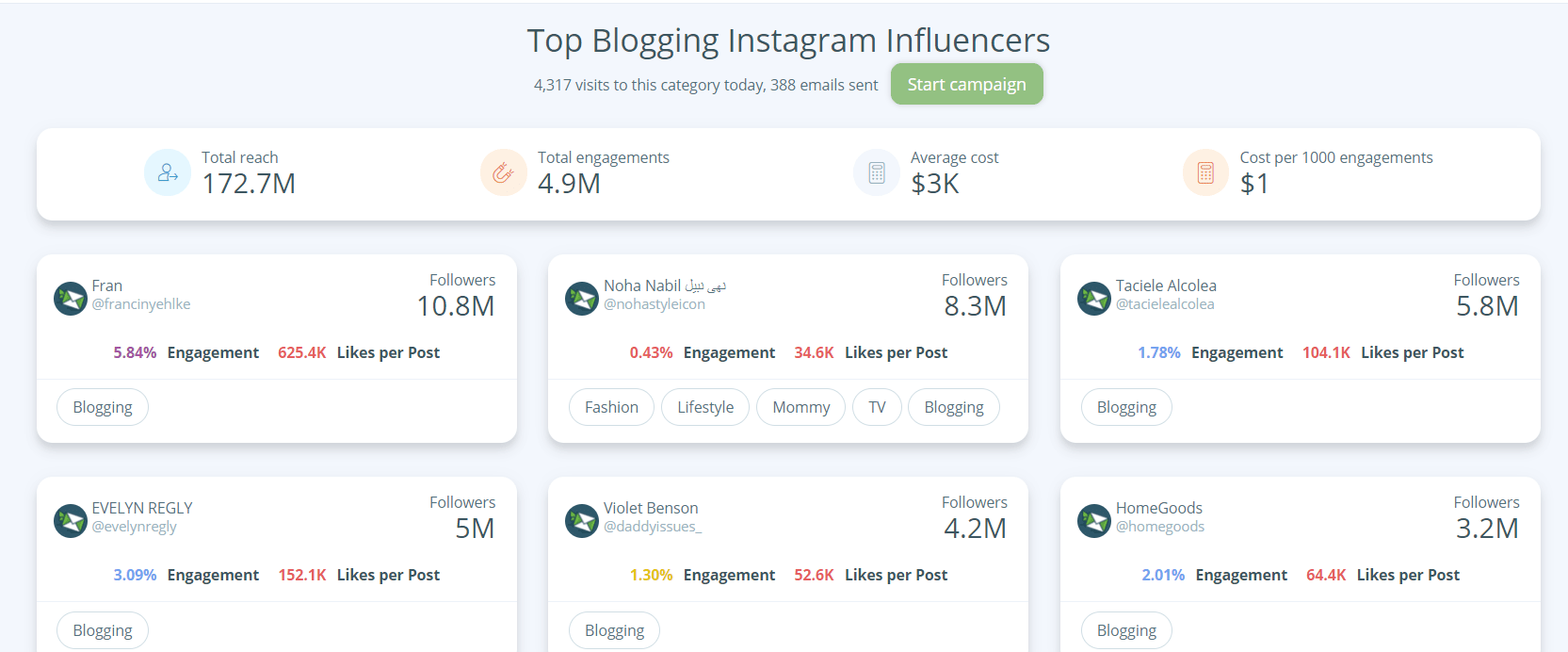
Additional engagement tips
Likes are not as popular an engagement metric as comments because they may not indicate genuine engagement. It’s a lot easier to double-tap on an image than it is to stop and leave a comment. Also, in the past Instagram has indicated that it would test hiding likes from the public. Only the profile owner would be able to view the number of likes on a post.
Also, when assessing an influencer’s engagement, review the engagement of sponsored posts vs organic posts. If organic content gets a much higher engagement rate, it could denote that this influencer lacks authenticity. If you see this discrepancy, but you still want to work with this influencer, have the influencer create content that mimics their top-performing posts. This is a good tip for any influencer if you’re going to boost ROI.
Influencer’s Reach
Reach refers to how many unique users see your content, but it can also refer to how much reach an influencer has outside of Instagram. Suppose an influencer also has a large following on Facebook, YouTube, or another social media site. In that case, when you work with this influencer, you may be able to expand your promotions outside of Instagram. An expansive network like this also indicates that the influencer has a broad reach and knows how to attract large communities on any platform.
How to Contact Influencers
For micro- and nano-influencers, reach out directly on Instagram or via email if they provide one in their profile.
Since marketers inundate popular influencers with similar requests, make your message stand out by following these tips:
- Engage with the influencer before you send the message. Like their posts and comment on their content. Show a genuine interest and an alignment of values without asking for anything in return.
- Be kind and empathetic. In your initial message, show influencers that you took an interest in their profile. Mention something you like or a recent post they published.
- Consider influencers as partners. Authentic Influencers might be concerned that your content may not align with theirs. As you engage in conversation, make it clear that you are looking for a creative partner, and you will give them creative freedom so they can use their authentic voice and style.
- Be concise. Get to the point, but keep the message warm and inviting. The influencer should never feel like they are being sold to, but rather that you are excited to start a rewarding partnership.
Below is a sample influencer outreach email:
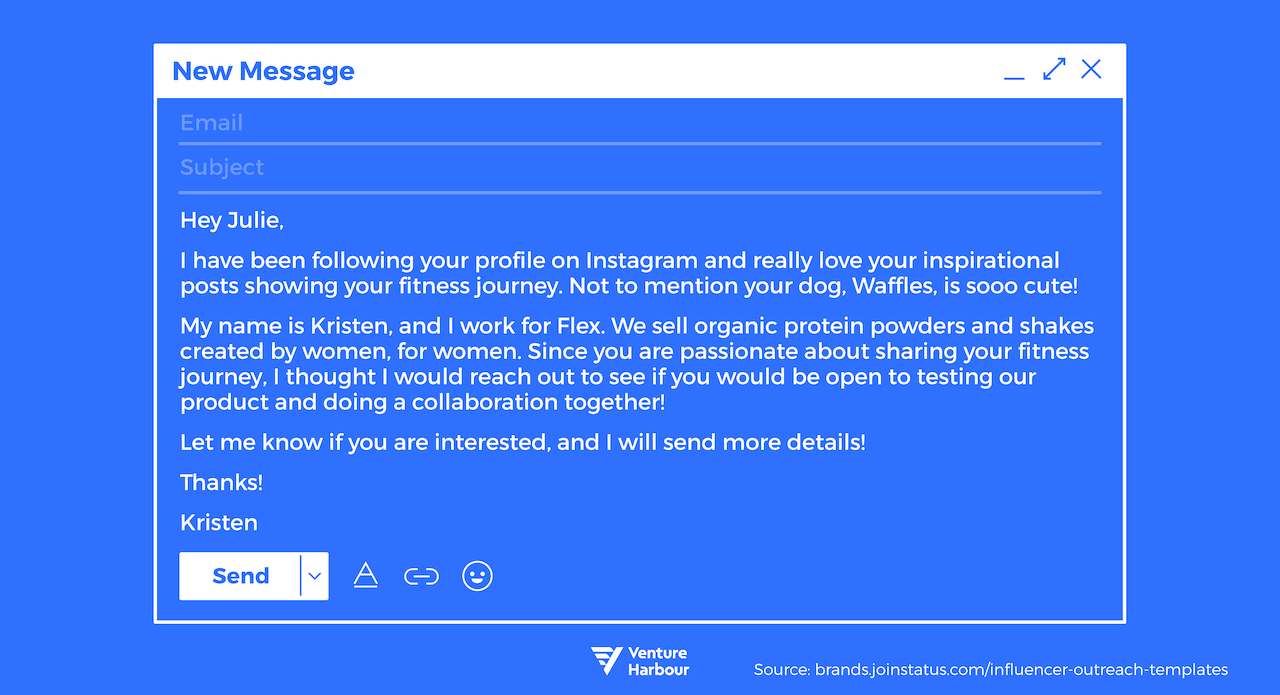
What Type of Content to Post
The content you collaborate on with your influencer will depend on your campaign goals. For example, if your goal is to get more sales conversions and measure sales as your KPI, you might want to post product photos and give influencers a discount code for their community.
Here are a few types of content for your influencer marketing campaigns:
Sponsored giveaways
You launch a product giveaway to spread brand awareness for your new product launch or special promotion. Partner with influencers to create content for your brand that features your products and the giveaway details.
Sponsored content
Sponsored content is what you would typically see influencers post. This content includes feed images and captions, or Instagram Story mentions of your brand and products, or both, depending on your goals.
The home goods store Bed Bath & Beyond works with influencers to show its products in real homes.
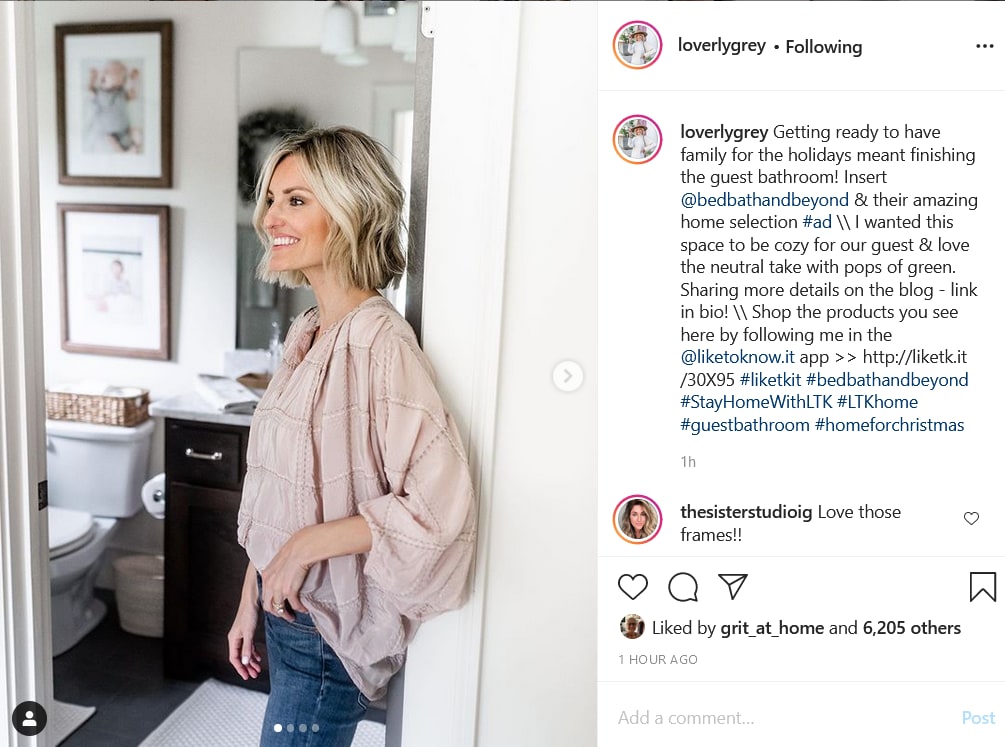
Branded content
Feature influencers in your content to show your brand’s popularity. You can also use the influencers’ photos (if you have permission) in your product shots and promotional messaging.
The apparel brand Good Night Macaroon features influencers on their website, Instagram feed and in promotional email messages.

Ambassador programs
Recruit brand ambassadors to post about your brand and products, and reward them with a percentage of the sales.
How to Measure the Success of Your Instagram Influencer Marketing Campaigns
How well are your Instagram influencer marketing campaigns performing? Are they better or worse than past campaigns? What metrics stood out to you? Did you meet your goals? Why or why not?
These are just some of the questions to ask yourself upon the completion of any influencer marketing campaign. But, to do so requires a deep dive into key marketing metrics we will cover below.
- Impressions – How many times a post has been seen by a user
- Engagement (post likes, comments) – A good metric to use to gauge whether the influencer will benefit your future campaigns or not. Use Cost per Engagement (CPE) which measures how much money each like and comment costs your campaign.
- Traffic – Measure the website traffic the influencer generated. To do this, use UTM code to provide each influencer with a unique tracking link.
- Conversions – The easiest way to gauge a campaign’s ROI is to track conversions using either a custom link or a custom discount code unique to each influencer.
- Profile growth – If one of your goals when launching your influencer marketing campaigns is to increase brand awareness, track how much growth (followers and engagement) you received for your brand’s Instagram profile after you launched a campaign. This is a little more difficult to track, but it starts with your goals (i.e., 10% follower increase in 10 days) and determining the value of each follower (customer lifetime value, etc.). Compare your pre-campaign with your post-campaign results to determine success.
Note that you will need to get some of this data directly from your influencers. Before you work with them, ensure they have an Instagram business account, and they are willing to share data on your content, and other content on their feed so you can compare metrics. You can also track metrics with analytics software such as Iconosquare.
Conclusion
The power of Instagram influencer marketing is there for brands willing to do the work. But launching marketing campaigns can still feel like a gamble—even if you leverage reliable data, set realistic goals, and plan accordingly.
